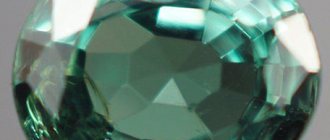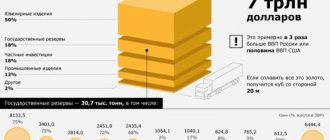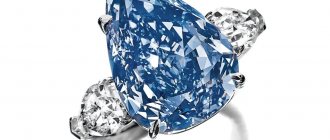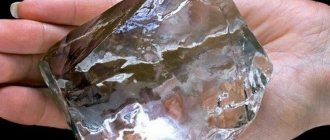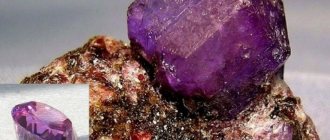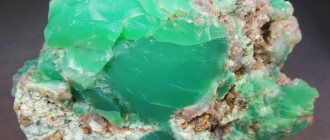Trade in nuggets has long gained popularity in developed countries. Thus, they are actively traded in the UAE, individual African countries, and the USA. A common purpose for purchasing such products is interior decoration. Gold blocks fit effectively into the luxurious furnishings of rich people's homes. However, nuggets are of greatest value as investment objects.
Rare pieces are the subject of competition between renowned collectors. They are ready to pay any money to acquire them.
Geologists also benefit from such profitable finds. With the help of their detailed examination, specialists are able to identify and predict gold deposits at the local level.
Mephistopheles
“Mephistopheles” is an unusual nugget weighing 20.2 grams, stored in the collection of the Diamond State Fund of Russia. It was found by gold miners in one of the mines in Chukotka in mid-1944. The piece of gold got its name due to its unusual shape, reminiscent of the profile of the literary character in the book “The Tale of Doctor Faustus,” Mephistopheles. It was initially assumed that the nugget had undergone pre-treatment before entering the museum, but long-term research showed that its shape was natural and not artificial.
Golden heart
The nugget was found in Alaska by miner Nick Martinex from California. The heart-shaped piece of gold weighs 2.55 kilograms (90 ounces). "Heart of Gold" originally looked like a rock covered in a crust of crystals and minerals. When Martinex accidentally hit it with a pickaxe, the shell split open, revealing some of the gold ore. The nugget was carefully removed from the soil, peeled, and then sold to the American Mint. The man who discovered the "Golden Heart" says he is proud of his find and was very worried that the piece of precious metal would not break when it was cleaned with a chisel.
Since man learned to extract gold from the bowels of the planet, over 200,000 tons of pure precious metal have been extracted. If you melt it down, you will get an equilateral cube the height of an eight-story building.
bunny ears
In the Urals, near the small settlement of Leninsk, one of the largest gold mines in Russia, discovered under Alexander I, operated for many years. At the beginning of 1935, when the gold mine was preparing to close, a lonely prospector Pyotr Simonov accidentally discovered a piece of gold in the ground, the weight of which exceeded 3.3 kilograms. But the nugget was considered unique not because of its mass, but because of its shape. It resembled a hare's head with long ears.
According to the laws of that time, such a large piece of gold could not remain the property of Simonov and he had to give it to the state. The nugget was placed in the royal treasury, from where it later ended up in the National Museum of Mineral Resources of Russia. The replica of “Hare Ears” is kept in the local history museum of the Chelyabinsk region.
First diamonds
The size of a fist.
10 facts about gold and nuggets of the Southern Urals. Interesting Facts. Photo: funart.pro There are diamonds in the Southern Urals. Before the Revolution, about 300 of these most durable and expensive stones in the world were found in the Chelyabinsk region. At that time, few people knew that crystals are very fragile. The mineral was placed on an anvil and hit with a hammer, it simply crumbled into dust - and people thought that it was not a diamond.
Camel
“Camel” is an unusual gold nugget, the shape of which resembles the outline of the body of the animal of the same name. It was found by Russian miners in the depths of a mine in Kolyma in 1947. The weight of the piece of precious metal was 9,300 grams. It was not melted down, but transferred to the collection of the Diamond State Fund, where it became one of the main exhibits. All visitors to the annual exhibition can look at the rare and unique nugget.
Horse head
In 1936, a large gold nugget of a strange shape, reminiscent of a horse's head, was found in one of the Ural mines. The elongated piece of precious metal weighed 13,700 grams. It was transferred to the collection of the Diamond State Fund of Russia. It is located next to another uniquely shaped “Dolphin” nugget. This piece of gold was discovered on the banks of the Lena in one of the largest gold deposits, Bodaibo. “Dolphin” is slightly inferior to “Horse Head” in weight. Its weight is 10,040 grams.
Royal gem
The "Iron Jewel" or "Royal Jewel" nugget is a single crystalline gold. It was discovered in a piece of quartz rock in 1992 at mines owned by the Sonora Mining Company. To avoid damaging the gold ore, the quartz shell was removed using hydrofluoric acid. The mass of the piece of precious metal was 16,400 grams. The nugget was donated to the Ironstone Vineyards Museum, which is located in the center of California. It has become a symbol of the state, which became famous throughout the world for the “gold rush” of the 19th century.
Normandy Nugget
Another name for the nugget is “Solid Normandy”. It was found in 1995 by miners working at a mine near the town of Calgourie (Australia). According to the data recorded in their diaries, the mass of a single piece of gold was 25.5 kilograms. After being melted down, it lost about 20% of its weight. The nugget was sold to the management of Newmont Gold Corporation. The gold bar, obtained after melting down a block of precious metal, is in the private collection of the Perth Mint.
“Norman nugget”, Australia, 25.5 kg
The weight of the so-called “Norman Nugget” is 25.5 kg, but the exact content of precious metal in it is unknown - according to various sources, it varies from 80 to 90%. It was dug out of the ground in one of Australia's largest gold mining centers in the city of Calgorie in 1995. Five years after the discovery, the prospector sold his treasure to one of the Australian companies, and it entered into a long-term agreement with the Perth Mint Museum, where the nugget is now on display.
Hand of Faith
A large piece of gold ore was found in early 1980 in the state of Kingover (Australia) using a metal detector. Its owner was the owner of a private gold mining enterprise, Kevin Hillier. The Hand of Faith weighed 27.6 kilograms and contained 870 ounces of pure gold. The nugget did not stay long in Kevin Hillier's collection. Soon he received an offer to sell it to the director of a famous gambling establishment in Las Vegas. The cost of the transaction remained secret. Today you can see the “Hand of Faith” in the museum located on East Fremont Street in the old Las Vegas area.
In Japan, a very popular show involves pulling a 12-kilogram gold bar through a small hole with your hands. The winner receives it as a reward.
Five Largest Existing Gold Nuggets
Throughout the history of gold mining and even during the gold rush, large nuggets were considered something extraordinary, always aroused the delight of professionals and captured the imagination of ordinary people. Perhaps this is partly due to the fact that it was very rarely possible to extract so much gold at once and relatively easily.
Gold nuggets are most often found in placers (sedimentary deposits formed by the movement of water) or other alluvial deposits, but also in or near primary deposits and weathered gold veins. Technically, “gold nuggets” can even be extracted from gold ore if the surrounding rock can be removed.
Many gold nuggets are said to be the largest. Obviously, not all statements can be trusted. There are many lists of “the world’s largest gold nuggets”, for unknown reasons including even those that have long been no longer in existence.
We believe that the list should include only those nuggets that have survived to this day, because previously many finds were melted down into gold bars or coins. In this regard, we conducted research, found out which of the known nuggets are still preserved in one piece and put on public display, and compiled a list.
1. Canae Nugget (Pepita Canaã), Brazil
The largest nugget in existence today, the Pepita Canaa Nugget, was found in 1983 by a prospector named Júlio de Deus Filho at the Serra Pelada mine in the Brazilian state of Pará.
The Kanae Nugget weighs 60.82 kg and contains 52.33 kg or 1682 troy ounces of gold. In 1984, it was acquired by the Central Bank of Brazil, and is now kept in the “Golden Hall” of the Museum of Money (Museu de Valores do Banco Central) in the capital, Brasilia.
It is noteworthy that the Kanae Nugget is part of an even larger nugget that fell apart while being pulled out of the ground.
Pepita Canaã, the largest surviving gold nugget, is on display at the head office of the Central Bank of Brazil in Brasília
In the early 1980s, Serra Pelada was one of the most popular gold mines in the world. More than 100,000 miners mined gold by hand in an open pit mine in indescribable, life-threatening conditions. The mine was closed in the late 1980s. It was flooded, and a state ban on mining was imposed, so it is simply impossible to find any gold there today. Despite this, Brazil still remains one of the main gold producers in the world. According to the US Geological Survey (USGS), in 2016 the production of the yellow metal in this country amounted to 80 tons.
Gold Rush in Serra Pelada, Pará, Brazil, 1980s
2. Big Triangle, Russia
The “Big Triangle” is the second largest surviving gold nugget, found in 1842 by Nikifor Syutkin in the Southern Urals (Miass region). Total weight - 36.2 kg, gold content - 91%, i.e. 32.94 kg or 1059 troy ounces of pure gold. The nugget, as its name suggests, has a triangular shape. Dimensions: 31cm x 27.5cm x 8cm. Found at a depth of 3.5 m.
"Big Triangle" in the Moscow Kremlin, Russia
The nugget belongs to the state, and through the Gokhran of Russia it is currently on display in the collection of the Kremlin's "Diamond Fund" in Moscow. The Diamond Fund presents the Russian collection of royal jewelry, precious stones, gold and platinum nuggets.
The Urals became one of the first gold-mining regions of the country. Currently, developments are underway in many regions of the Russian Federation, mainly in the eastern part. Today Russia ranks 3rd in gold production in the world. In 2016, 250 tons of yellow metal were mined in the country.
3. Hand of Faith, Australia
“Hand of Faith” is a gold nugget weighing 27.66 kg, discovered in 1980 by local resident Kevin Hillier near Kingauer, PC. Victoria, Australia. The largest gold nugget found using a metal detector. Gold content: 875 troy ounces. Dimensions: 47cm x 20cm x 9cm.
"Hand of Faith" was acquired by the American casino Golden Nugget Casino. Today the nugget is on display in the lobby of the casino located on East Fremont Street in downtown Las Vegas, USA. Nevada, USA.
Hand of Faith Nugget at Golden Nugget Casino, Las Vegas
According to the casino website, the “Hand of Faith” nugget is the largest of all that have survived to date, which, of course, is not true, because. there is also the Brazilian “Pepita Canaã” and the Russian “Big Triangle”.
4. Normandy Nugget, Australia
The Norman Nugget weighs 25.5 kg (820 oz). It was found in 1995 in Kalgorie in Western Australia, a major gold mining center. Quantitative analysis showed that the Norman Nugget contained between 80% and 90% gold.
In 2000, the Normandy Nugget was purchased from the prospector by Normandy Mining, now owned by Newmont Gold Corporation. The nugget is currently on display at the Perth Mint Museum and has a long-term agreement with Newmont.
"Norman Nugget" at the Mint, Western Australia
In the 1880s, when gold was first discovered in Western Australia, the region became the country's most important gold-mining area. Today, Calgourie is home to one of Australia's largest open-pit mines, the Super-pit.
According to the USGS, Australia ranks second in the world in gold production - 270 tons in 2021.
5. Ironstone's “Crown Jewel”, California
Ironstone's "Crown Jewel" nugget is crystalline gold leaf. It was discovered by the Sonora Mining Company in 1992 in California. The gold was in quartz rock. Using hydrofluoric acid, almost all of the quartz was removed and a single piece weighing 44 troy pounds (16.4 kg) was recovered.
Ironstone's "Crown Jewel", crystal gold leaf
Currently, the Ironstone “nugget” is on display at the Ironstone Vineyards Museum in California, sometimes called the “Kautz Crystalline Gold Leaf Specimen” in honor of John Kautz , owner of Ironstone Vineyards.
Gold and California have been inextricably linked ever since the gold rush hit northern California in the late 1840s and early 1850s. According to the USGS, the country produced 209 tons of gold in 2021, making America the fourth largest gold producer after China, Australia and Russia. Today, the main gold-producing states are Nevada and Alaska, although mining is still underway in California, for example at New Gold's Mesquite mine.
Notes:
The Museum of the Central Bank of Brazil displays several more gold nuggets found in Serra Pelada. Three of them clearly exceed both the “Hand of Faith” and the “Norman Nugget” in weight (30.56 kg, 29.89 kg and 28.2 kg). However, none of the Brazilian nuggets became famous as “Pepita Canaã”, so the country’s central bank prefers to display them anonymously. Technically, these Serra Pelada nuggets would move both the Australian specimens and the Ironstone nugget down.
Two nuggets found in Australia (Victoria) at the beginning of the 19th century also exceeded the size of the Brazilian "Pepita Canaã" and are still sometimes included in "lists of the world's largest gold nuggets." The first was called “The Welcome” and was found in Ballarat in 1858 during the Victorian Gold Rush. The extracted piece weighed about 69.98 kg. However, the "Long-Awaited" was sent to London and in 1859 melted down by the Royal Mint into gold coins. A copy of "The Long Awaited" can be seen in many Australian museums.
The second nugget, "Welcome Stranger", was found in the state. Victoria in 1869. Its weight, according to various estimates, varies, but we can say for sure that it contained more than 70 kg of gold. A few days later, the "Welcome Stranger" was cut into pieces, melted into ingots and sent via Melbourne to the Bank of England. Anyone can see a copy of The Welcome Stranger today at the Melbourne City Museum.
Support GOLDENFRONT.RU, subscribe to our YOUTUBE channel HERE .
Big triangle
The largest gold nugget found in Russia in 1842. It was dug up by Nikifor Syutkin, an employee of the Ural gold mining company, at a depth of 3.5 meters. The weight of the block of precious metal was 36,200 grams, of which 91% was pure gold. The nugget was named “Big Triangle” because of the shape of the ore piece. From the moment the block is extracted, it is considered the property of the Russian Empire. It was placed in the collection of the Diamond State Fund next to large precious stones and the largest platinum nuggets found in the country.
The Golden Giants drew crowds of spectators
Interesting finds were also discovered by gold miners in the United States of America, which has rich deposits of natural gold. Some of them became real entertainment for the local public. For example, in 1954, there was an amazing discovery of a golden giant in California. A local prospector was digging a grave for his deceased friend and gold-hunting companion when suddenly his shovel came across a boulder. When the excited prospector dug up this huge stone, it turned out that in front of him was a real gold nugget, searching for which he and his deceased comrade spent more than one year of their lives.
The weight of the Californian giant was 36 kilograms. In honor of his late comrade, the owner named the nugget “Oliver Martin.” The enterprising businessman organized a whole tour of the States. He came to different cities, where he demonstrated his weighty find to a curious public. From these demonstrations he managed to earn about ten thousand dollars. And when the tours stopped bringing him a stable income, the owner sold his gold “Oliver” for 22.7 thousand dollars.
And in the 80s of the twentieth century, in the same Australia, in the state of Victoria, a gold prospector named Kevin Hiller discovered a massive gold nugget called the “Hand of Fate.” The weight of this golden stone of an unusual shape, reminiscent of a human palm, reaches 27.2 kilograms.
Dimensions of the nugget “Hand of Fate”
| Quantity | Options |
| 47 centimeters | in length |
| 20 centimeters | in width |
| 20 centimeters | thickness |
This gold has 926 purity. To date, it is considered the largest gold nugget found using a metal detector. At first, the successful gold miner put it up for auction, intending to sell it at home, and this idea was supported by the local government. But for several months, none of the Australian rich were able to offer a decent price for the gold giant.
The federal government somewhat delayed issuing official permission to sell the precious find abroad, hoping that it would still remain on the territory of the state. Meanwhile, the value of gold began to plummet, and seeing this, the federal government gave in and issued the necessary permit. Officials understood that further delays in completing the paperwork would result in the federal treasury receiving a smaller amount of tax for the find than previously calculated. As a result, the famous gold nugget was purchased by one of the casinos located in Las Vegas, USA. The owner earned one million dollars from this transaction. And the huge golden hand is put on public display in a glass display case, and all visitors to the casino can enjoy the view of this giant. In 2010, in Australia, at the place where Kevin Hiller discovered his miraculous find, a monument was unveiled - this is an exact copy of the “Hand of Fate”.
Pepita Kanaa
A piece of gold weighing 60.5 kilograms was found in Brazil in 1983 by a miner with many years of experience, Julio Filo. When extracting a nugget from the depths of the Serada-Palada mine, it was accidentally split into two unequal parts. The ore was bought by a coin minting company. A huge coin was smelted from it, which was called Pepita Kanaa. The weight of the product was 52 kilograms. 8.5 kg of impurities were sifted out during the process of melting down a piece of gold. The coin was transferred to the monetary museum of the State Bank of Brazil, where it remains to this day as the main exhibit. Anyone can look at this masterpiece of the mint.
“Nugget Kanae”, Brazil, 52 kg
Large gold nuggets are not very common. Even samples weighing one hundred grams are considered rare and a great success for the miner. What can we say about gold blocks weighing several tens of kilograms, which can be discovered once every few decades.
The largest nugget to date is considered to be the “Canae Nugget,” found in 1983 by miner Julio de Deus Filho in the Brazilian state of Pará.
The entire Kanae Nugget weighs 60.82 kg, but it contains slightly less gold - 52.33 kg. It is known that "Kanae" was part of a larger nugget that broke into pieces when it was pulled out of the ground. A year after its discovery, the find was purchased by the Central Bank of Brazil.
Now everyone can look at it in the “Golden Hall” of the Museum of Money in the city of Brasilia.
Nugget Henry Share
Despite the fact that the “gold rush” came to an end a long time ago, gold miners do not stop digging in the earth in search of precious ore. In 2021, Australian miner Henry Dole decided to start excavations near the town of Kambalda. In September, luck smiled on him. In one of the walls of a nickel mine, he discovered a rich deposit of gold. After the explosion, the floor of the adit was strewn with pieces of precious metal, the largest of which weighed 90 kilograms. Another nugget had a mass of 65,200 grams. After melting it down, a 45-kilogram ingot was obtained. It is unknown where the nuggets found by Dole went, but in the place where the lone miner was excavating, a mine was built for the extraction of minerals.
What is a gold nugget?
Gold nuggets are large pieces of native metals. Experts have not yet come to a consensus on which piece of gold should be called a nugget.
Some professionals call for ingots weighing more than 1 kg to be called nuggets, while others are inclined to think that a piece measuring about 4 mm rightfully deserves such a name if nature has endowed it with a unique shape and bright shine.
It was the nuggets found that became the beginning of people’s acquaintance with precious metals. They marked the beginning of the history of using gold as a material for making jewelry and other items.
The cost of nuggets is determined by their size. The larger the piece, the more expensive the price will be. Thus, the average cost of Australian nuggets ranges from $18 per gram if it is less than 6 grams, and $30 per gram for larger specimens (from 8 to 16 grams).
When determining the value of a nugget, important importance is given to such a factor as its shape. The original version made of pure gold costs several times more than a rolled copy mined from placers. Therefore, the search for such finds is justified.
You may be interested in: Which gold is more expensive: white or yellow?
Gold mining often brings good luck in the form of nuggets found. If we compare gold with other metals, then its concentration in the soil is much less than the same iron, copper, lead and others. However, scientists have found that the noble metal is also present in plants and living organisms.
Welcome Stranger
“The Welcome Stranger” is one of the largest gold nuggets found in Australia by prospectors John and Richard in one of the private mining mines. The weight of a piece of precious metal is almost 70 kilograms. The mass of the nugget was so large that there were no scales in the village to weigh it and determine the exact weight. A piece of ore was divided into several parts and sent to England. There it was melted down into the largest bar of gold and placed in a public bank in London.
Golden Lake
The size of a fist.
10 facts about gold and nuggets of the Southern Urals. Interesting facts about gold and gems. Photo: yatakviju.mirtesen.ru Lake Inyshko, next to Turgoyak, is considered one of the most “golden”. True, no nuggets were found there, but, according to legend, at its bottom lies the treasure of Emelyan Pugachev. There is a version that the rebel ordered a couple of barrels of gold to be drowned in a pond when he was leaving his pursuers. The problem is that the peat and silt make the lake bottom so muddy and dark that looking for anything there is like looking for a needle in a haystack.
Holtermann plate
The “Holtermann Plate” is the largest gold nugget on the planet, which was extracted from the depths of the Earth in the fall of 1872. Gold miner Holterman and his colleague Hugo Beyens found a piece of gold weighing 235 kilograms. After melting the nugget, it turned out that it contained only 83 kilograms of pure gold ore. The rest of the piece consisted of quartz, iron and other impurities. However, despite this, the “Holterman Plate” is recognized as the largest gold nugget included in the Guinness Book of Records. Unfortunately, the piece of precious metal has not survived to this day. All information about him was obtained by scientists from entries in the personal diary of Hugo Beyens.



